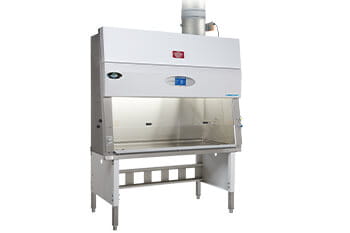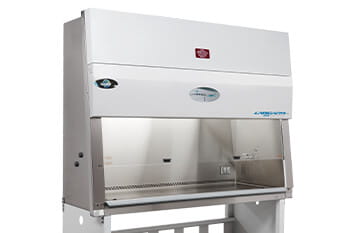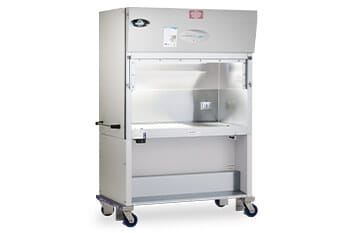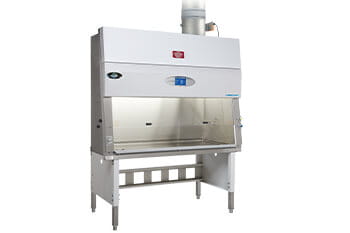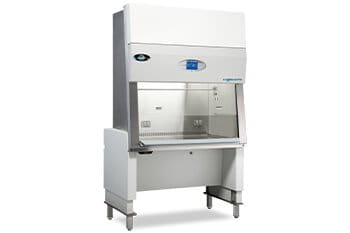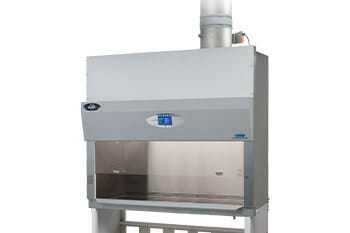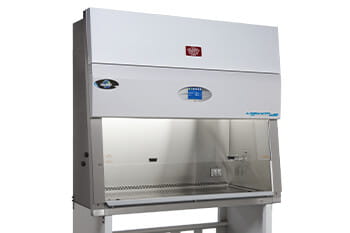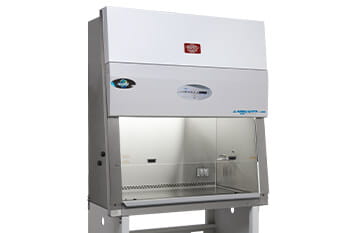Article
Biosafety Cabinet Types
6/27/2024Class II Biosafety Cabinets (BSCs) are essential for laboratories that handle infectious agents and hazardous materials. These cabinets provide three levels of protection: personnel, product, and the environment. This article will discuss how Class II BSCs achieve these protection levels, focusing on standards and guidelines from NSF/ANSI 49, EN 12469, and the Biosafety in Microbiological and Biomedical Laboratories (BMBL) manual.
Personnel Protection
Airflow Mechanisms
Class II BSCs protect personnel through carefully designed airflow patterns. The cabinet face velocity is maintained at a minimum of 100 feet per minute (fpm), ensuring that air flows inward through the front opening, preventing contaminants from escaping the cabinet and entering the laboratory environment.
HEPA Filtration
High-Efficiency Particulate Air (HEPA) filters are integral to personnel protection. These filters capture 99.99% of particles that are 0.3 microns or larger, effectively trapping harmful agents used within the cabinet. The air passing through these HEPA filters before being exhausted or recirculated ensures that personnel are not exposed to hazardous aerosols or particulates.
Negative Pressure
The internal ductwork and plenums of Class II BSCs are under negative pressure relative to the room. This design ensures that any potential leaks in the cabinet are contained within the cabinet itself, preventing contaminants from being expelled into the laboratory. Negative pressure zones serve as an additional barrier to ensure contaminants do not escape.
Ergonomic and Safety Features
Class II BSCs incorporate ergonomic designs to enhance user safety. Features such as sloped front sashes, adjustable stands, and ample knee clearance reduce physical strain, allowing users to work comfortably for extended periods. These cabinets also meet the Americans with Disabilities Act (ADA) requirements, ensuring accessibility for all users.
Product Protection
Unidirectional Airflow
Product protection is achieved through vertical unidirectional airflow, also known as laminar flow. This airflow pattern ensures that air moves smoothly and uniformly from the top of the cabinet down to the work surface, minimizing turbulence and preventing cross-contamination within the work area.
HEPA Filtration
HEPA filters are also crucial for maintaining a contaminant-free environment within the cabinet. The filtered air creates a clean air environment, protecting samples and materials from contamination by external pollutants or particles.
Air Curtain and Air Foil Design
Class II BSCs feature an aerodynamic air foil and air curtain that directs airflow into the front grille. This design helps isolate the work area from the surrounding environment, reducing the risk of contaminants entering the work zone from the room or from the user.
Routine Cleaning and Maintenance
To maintain product protection, BSCs are designed for easy cleaning and decontamination. Removable work surfaces, accessible drain valves, and smooth interior surfaces with coved corners minimize areas where contaminants can accumulate, ensuring the work area remains sterile.
Environmental Protection
Exhaust Systems
Class II BSCs use sophisticated exhaust systems to protect the environment from hazardous materials. Depending on the cabinet type, the exhaust air can either be HEPA-filtered and recirculated back into the room or expelled outside the facility through a dedicated duct system. Type B2 cabinets, for example, exhaust 100% of the air outside the facility, making them suitable for work with volatile chemicals and other hazardous substances.
Energy Efficiency
Modern BSCs incorporate energy-saving features that reduce operational costs and minimize environmental impact. Energy-efficient motors, such as Electronically Commutated Motors (ECM), consume less power and produce less heat, reducing the strain on the laboratory's HVAC system and lowering overall energy consumption.
Compliance with Standards
Class II BSCs comply with stringent standards such as NSF/ANSI 49 and EN 12469, which define criteria for the design, construction, and performance of biosafety cabinets. These standards ensure the cabinets provide the necessary protection levels for personnel, product, and environment, and are routinely validated through testing and certification.
Waste Management
Many Class II BSCs include integrated waste management systems that allow for the safe disposal of hazardous materials. Features such as waste disposal systems within the work zone and options for connection to glove boxes or biohazard bags help contain and manage waste without compromising the sterile environment of the cabinet.
Standards and Guidelines
NSF/ANSI 49
The NSF/ANSI 49 standard outlines the requirements for Class II (Laminar Flow) BSCs. It covers aspects such as cabinet construction, performance, and testing to ensure the highest level of protection for personnel, products, and the environment. This standard requires cabinets to be tested for containment, airflow, and HEPA filter integrity.
EN 12469
EN 12469 is a European standard that specifies the performance criteria for microbiological safety cabinets. It includes guidelines for airflow patterns, HEPA filtration, and ergonomic design. Compliance with EN 12469 ensures that BSCs meet rigorous safety and performance standards, protecting both the user and the environment from exposure to hazardous materials.
Biosafety in Microbiological and Biomedical Laboratories (BMBL)
The BMBL manual, published by the Centers for Disease Control and Prevention (CDC) and the National Institutes of Health (NIH), provides guidelines for biosafety practices in laboratories. It includes recommendations for the use of BSCs, outlining best practices for their operation and maintenance to ensure a safe working environment. The BMBL emphasizes the importance of proper training, regular maintenance, and adherence to safety protocols to maximize the protective capabilities of BSCs.
Conclusion
Class II Biosafety Cabinets are essential tools for maintaining safety and sterility in laboratories that handle infectious agents and hazardous materials. Through sophisticated airflow mechanisms, HEPA filtration, ergonomic designs, and compliance with international standards, these cabinets provide comprehensive protection for personnel, products, and the environment. Regular maintenance, proper use, and adherence to safety protocols are crucial to ensuring these protective measures remain effective.
Bibliography
NSF International. "NSF/ANSI 49: Biosafety Cabinetry: Design, Construction, Performance, and Field Certification." 2022.
European Committee for Standardization. "EN 12469: Biotechnology - Performance Criteria for Microbiological Safety Cabinets." 2000.
Centers for Disease Control and Prevention and National Institutes of Health. "Biosafety in Microbiological and Biomedical Laboratories (BMBL)." 5th edition, 2009.

